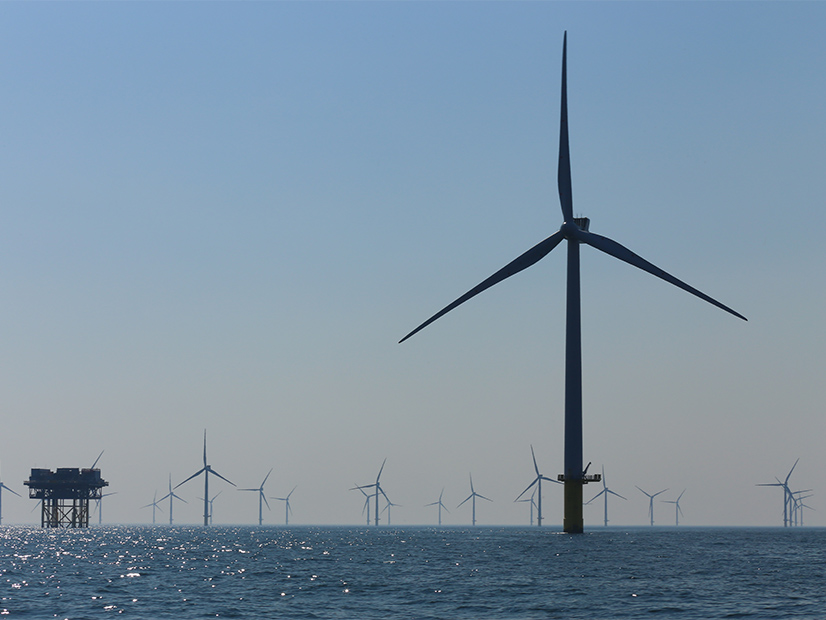Massachusetts and Rhode Island have selected 2,878 MW of offshore wind project bids from the states’ coordinated solicitation, which would make it the region’s largest offshore wind procurement.
The multistate solicitation, which included Connecticut, initially sought up to 6,000 MW in bids and ultimately received 5,454 MW. (See New England States’ OSW Procurement Receives 5,454 MW in Bids.) On Sept. 6, Massachusetts announced its selection of 2,678 MW from three project bids, while Rhode Island selected 200 MW. Connecticut did not announce any project selections, writing in a statement that “the evaluation of project bids remains underway.”
Massachusetts and Rhode Island selected the SouthCoast Wind project, with Massachusetts planning to buy 1,087 MW and Rhode Island planning to buy the project’s remaining 200 MW. Massachusetts also selected 791 MW from Avangrid’s New England Wind 1 project and “up to 800 MW” from Vineyard Offshore’s Vineyard Wind 2 project.
Vineyard Wind 2, which originally was proposed as a 1,200-MW project, could reach power purchasing agreements with other states or private entities, according to Massachusetts officials.
The project selection falls short of the authorized procurements for both Massachusetts and Rhode Island; Massachusetts’ request for proposals (RFP) authorized the selection of up to 3,600 MW, while Rhode Island sought up to 1,200 MW. The Massachusetts legislature has set an offshore wind procurement target of 5,600 MW by 2027. Representatives of both states say they plan a subsequent solicitation in 2025.
“Together with Massachusetts, we are setting a precedent for regional collaboration in clean energy and advancing a sustainable, resilient future,” said Rhode Island Gov. Dan McKee (D) in a statement.
Massachusetts Gov. Maura Healey (D) said at a press conference the selection marks “a historic step forward toward energy independence, cleaner air and transformation of our economy.”
Healey told reporters the projects ultimately will result in “lower electricity costs for our residents and our businesses.” She said state and independent evaluators determined that “this is a cost-effective way, one of the most affordable ways, for us to bring that power online in Massachusetts.”
State officials did not disclose project costs, saying details will remain under wraps until contracts are submitted to state utility regulators. Cost has been a key concern for policymakers and stakeholders throughout the solicitation process. The Massachusetts Attorney General’s Office recommended in 2023 a smaller-than-authorized procurement to limit costs to ratepayers. (See Mass., RI, Conn. Sign Coordination Agreement for OSW Procurement.)
In 2023, SouthCoast backed out of its power purchase agreements with Massachusetts utilities, citing inflation, interest rates and supply chain constraints. (See Developer Seeks to Terminate SouthCoast Wind PPAs.)
To help mitigate future cancellation risks, each of the three state’s RFPs included the option for developers to submit inflation adjustment mechanisms for their projects. Massachusetts officials said none of selected projects include adjustment mechanisms.
Massachusetts’ Executive Office of Energy and Environmental Affairs Secretary Rebecca Tepper emphasized the projects would help reduce dependence on natural gas, resulting in lower emissions and less price volatility.
Tepper said the selection will help the state “lead the nation in the global race for developers, vessels, materials and expertise. We’re going to lock in jobs and technical expertise, and we’re going to invest in our ports.”
Massachusetts officials indicated the bulk of the work is set to be based out of New Bedford and Salem, with work also occurring in the ports of New London and Providence. All three projects selected include project labor agreements, and they are projected to create thousands of jobs across the region. New England Wind 1’s expected in-service date is 2029, while SouthCoast expects to power up by 2030.
A range of clean energy organizations praised the announcement, emphasizing the importance of continuing to invest in the development of the region’s offshore wind industry.
Kelt Wilska of the Environmental League of Massachusetts called the project selection “a big win for Massachusetts and Rhode Island.” Wilska also praised the collaborative solicitation process.
Amanda Barker of Green Energy Consumers Alliance called on the states to continue to invest in offshore wind and “to issue additional solicitations to ensure we meet our climate targets and access the wide-ranging benefits of offshore wind.”
The developers of the SouthCoast and Vineyard Wind 2 projects both applauded the project selection announcement. Vineyard Offshore did not release a statement, and NetZero Insider was unable to reach the company for comment in time for publication.
Project developers now will negotiate contracts with the electric distribution companies in Massachusetts and Rhode Island. The finalized contracts then will be filed with state utility regulators.
On the transmission side, Massachusetts’ press release noted the New England states are positioned to “request that ISO New England issue a competitive solicitation for proposals to address longer-term transmission needs, such as transmission to interconnect offshore wind or other clean energy resources, in late 2024 or early 2025.” (See FERC Approves New Pathway for New England Transmission Projects.)



